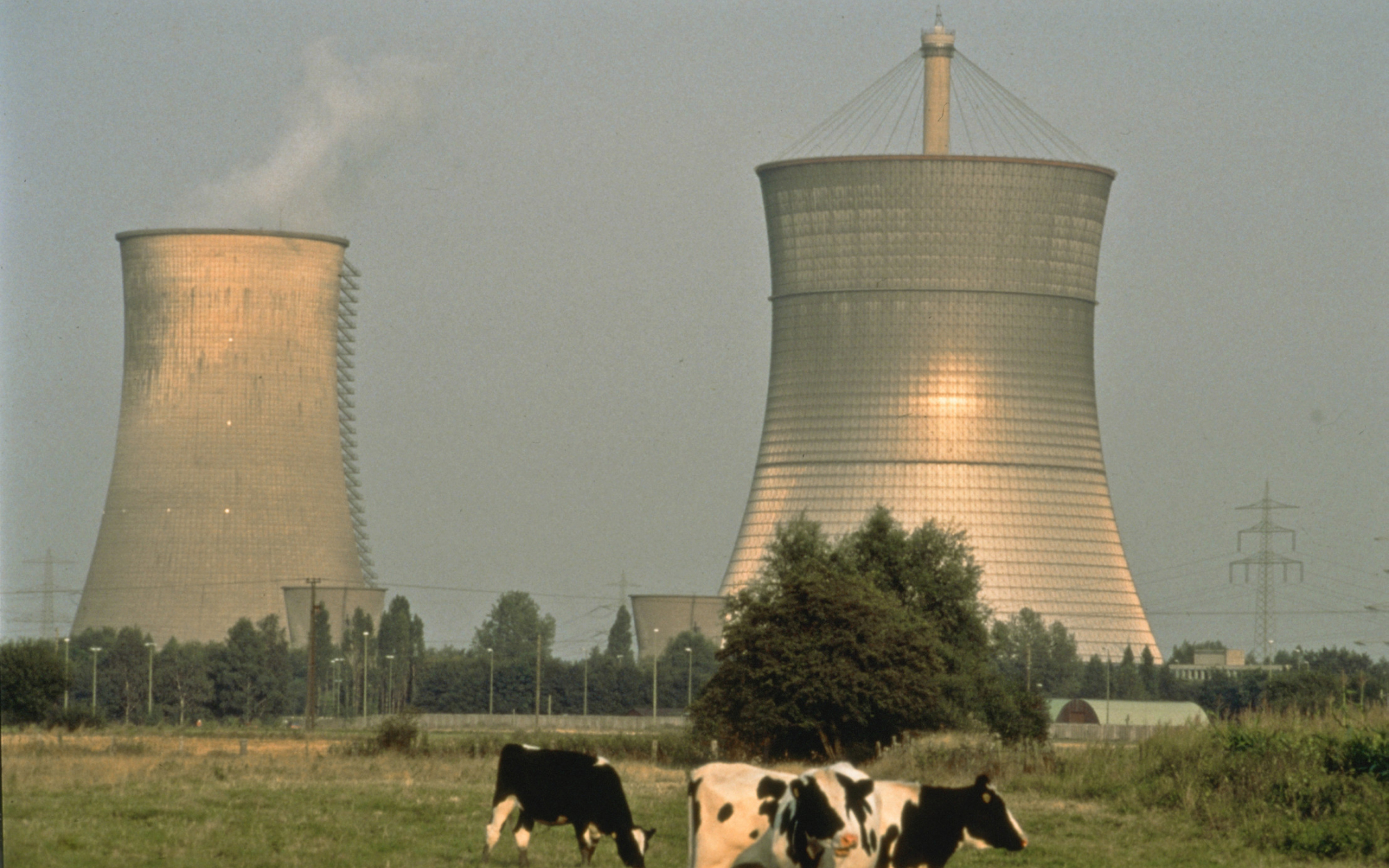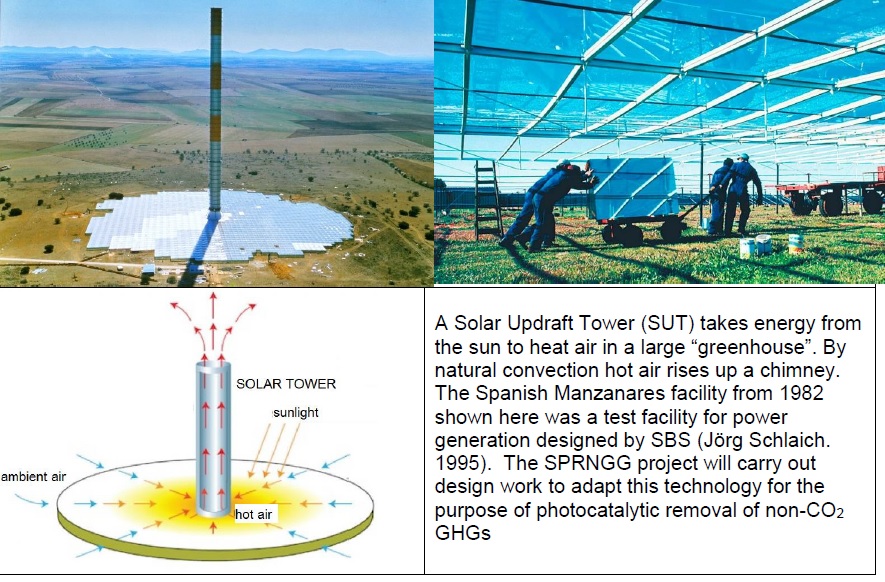
SUGGRSolar Updraft
|
SPRNGGSolar Photocatalytic Removal
|
The SUGGR/SPRNGG project addresses a GGR technology appropriate to meeting the Paris COP21 target.

In this multi-disciplinary project, chemists will investigate and optimise the choice of catalysts and their operating conditions for the elimination of the three high global warming potential (GWP) non-CO2 gases (HiGWPGs). They will also consider the manufacturing processes and costs implied in scaling the process to climatic significance. Atmospheric scientists will investigate the local and global climatic impacts of reducing the atmospheric concentration of HiGWPGs. This will include seeking confirmation of initial expectations that the climatic benefits will not be offset by interactions with the ocean, nor that any harm might be caused by 'rogue' by-products from the photocatalysis.
SUTs were originally conceived as solar powered electricity generators. SUGGR/SPRNGG will repurpose this technology as a means of delivering the mass airflow necessary to process the quantity of air required to eliminate HiGWPGs at a climatically significant scale. However, SUGGR/SPRNGG also recognises that the UNFCCC's objectives are unlikely to be met without some capture and sequestration of CO2. The construction of a full scale SUT to deliver air for the photocatalytic elimination of HiGWPGs, offers a valuable experimental environment in which to further examine the at-scale capture and sequestration of atmospheric CO2.
Any intervention in the global climate will have wide societal, ecological and environmental impacts, indeed, it is intended to do so as a means of averting the dangers of excessive global warming. However, this positive outcome might be accompanied by some undesirable outcomes, some of which might be anticipated and others not. Policymakers have an obligation to present and future generations to ensure that the side effects of their interventions in the global climate will not be unacceptable. Rather than a problem that will be solved, climate change is a situation that must be managed. Means must be found whereby policymakers can make sound assessments of the potential impacts, both positive and negative, of alternative policy choices and then monitor these as policies are implemented in order that they can be adapted to changing circumstances, new knowledge and evolving perceptions of different communities about what is and is not acceptable. SUGGR/SPRNGG embraces these uncertainties and in the social science and complexity science components will investigate and develop policy processes that will inform policymakers' decision making in relation to GGR.
To date little attention has been given to the removal of atmospheric non-CO2 GHGs. Global Warming Potential (GWP) is a measure of the potency of a GHG and many non-CO2 atmospheric gases have a high GWP. The three most important (methane (CH4), nitrous oxide (N2O) and dichlorodifluoromethane (CCl2F2 - also known as CFC-12) - collectively HiGWPGs) represent almost 30% of radiative forcing (RF) of the long-lived (lifetimes = 10 years) GHGs. Whereas the removal of atmospheric CO2 could lead to significant re-emission from the ocean, this is likely to be less significant for atmospheric HiGWPGs given their relatively small presence in the ocean. HiGWPGs can be eliminated by photocatalysis (PC) transforming them into benign atmospheric gases, water vapour and small amounts of volatile compounds, all of which would be much less active GHGs than their precursors and easily dispersed in the atmosphere. Assessment of the potential environmental impact of these products dispersed in the upper troposphere is central to the SPRNGG project. Here are the gas-phase reactions at the core of the SPRNGG project:
2N2O => 2N2 + O2
CCl2F2 + 2H2O => 2HCl + 2HF + CO2
CH4 + 2O2 => 2H2O + CO2
The photocatalyst enables us to harness sunlight to promote the destruction of CH4, N2O and the fluorocarbon. A major feature of the SUT+PC process is that no capture or sequestration is necessary, thus greatly reducing costs and risks, and therefore the lead time to deployment. These installations have virtually no moving parts and should therefore have a working life well in excess of 100 years, sufficient to secure their economic justification. They will also be almost maintenance free save for the cleaning of the solar collector and the periodic refreshing of the photocatalytic surfaces. Attractive as the elimination of HiGWPGs may be, it may not be enough to secure the UNFCCC target without the removal of some atmospheric CO2. Moreover, only the reduction of atmospheric CO2 will address ocean acidification. The mass airflow through a SUT can equally be used to capture CO2, however the processes of direct air capture and sequestration of CO2 require further research to reach multiple gigatonne per annum scale. Depending on operating conditions, 1,000 SUTs could access some 70GtCO2/yr, requiring only 50% efficiency to capture as much carbon as is currently being emitted. This project will scope the research needed to assess SUTs as the front end of climate scale CO2 capture and sequestration.
The project's research questions are:
The core theory of SUTs as a source of solar powered electricity generation was established in the 1980s using a large experimental prototype. Since then further theoretical work has been undertaken to improve their performance for power generation. In addition to repurposing SUTs as a delivery mechanism for a giant photocatalytic reactor (GPR), this project will also consider ways in which they could be used as an experimental environment for the research and development of CO2 capture and sequestration, and in particular investigate ways in which, using abundant solar power, it could be sequestered in solid form as a means of avoiding the liquefaction of CO2 for subterranean storage, thereby ensuring more permanent and lower risk storage, and easier monitoring, reporting and verification of amounts sequestered, a factor likely to be of considerable importance in the geopolitics of GGR.
The project also confronts the challenge of informing policymakers of the relative merits of alternative GGR approaches given their diverse modes of operation and the considerable differences between the range and nature of their consequential impacts. Life cycle analysis (LCA) is codified in a series of ISO standards. These standards, and derivatives of them, are largely designed to encourage manufacturers and service providers to account for the wider ecological and environmental impacts of their products throughout their lives. . However, standard LCA does not deal well with products implemented in future global scenarios that are very different from the current ones. To extend the standard approach, the project will apply methods developed in complexity science to consequential LCA (CLCA) to identify those factors required by a comprehensive CLCA capable of sound discrimination between alternative GGR approaches to be been used in the later stages of the programme for inter-consortia comparison. It will address boundary setting, non-linearity and path dependency, and valuation issues arising from the discounting of monetary values over extended periods and impacts of systems and processes that defy monetisation. The project will illustrate the implementation of this methodology by its application to the SUT+PC combination to eliminate HiGWPGs at a climatically relevant scale. Major achievements of this project are anticipated to be threefold: